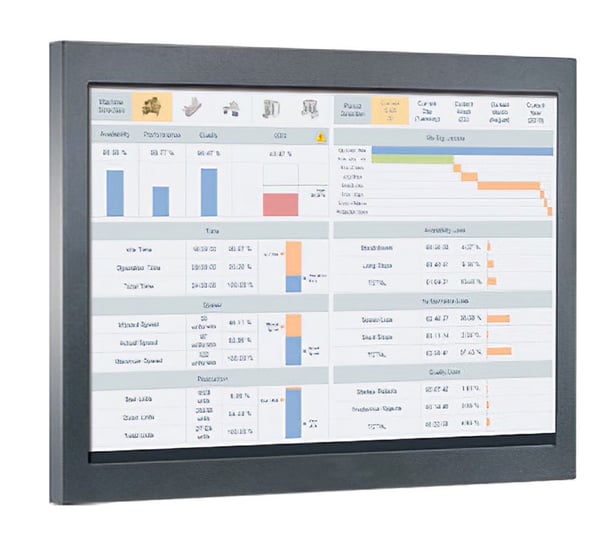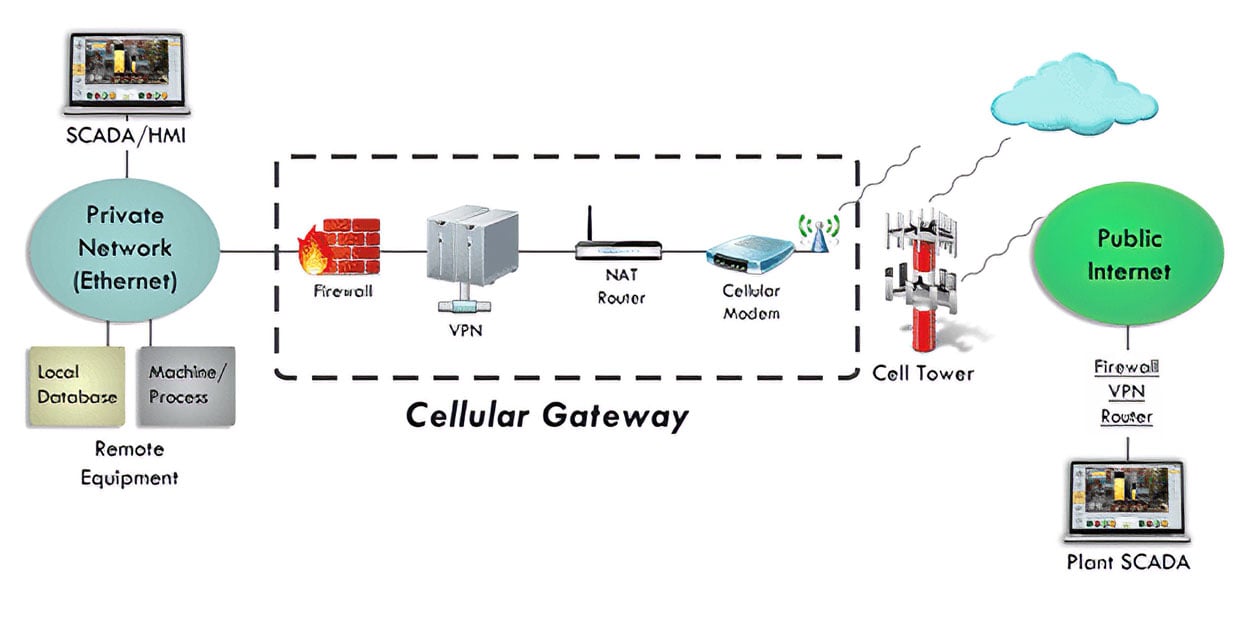The Internet of Things needs technology to connect people to machines and processes. From the operators on the plant floor to the execs in the C-suites, supervisory control and data acquisition (SCADA) data is expected to be available. Production data, key performance indicators, fault history, and process variable trends are just some of the information that needs to be collected and displayed. The demand for this and other data continues to grow.
When the machines or processes are on a plant floor, tried-and-true methods of connecting their data to human-machine interfaces (HMIs), databases, or the cloud are available. A hardwired Ethernet connection, usually via an industrial Ethernet protocol, is a popular choice for connectivity. As the distance to the machines increases or where the application allows, a local and secure Wi-Fi connection can be used.
When machines and processes move to remote sites, public communication methods, such as phone lines, radio, and satellite, become better choices. Each method has its strengths and weaknesses. Another over-the-air communication method is cellular, which in the past has been too expensive for many applications. But with proper cellular hardware selection, the right protocol, proper network configuration, and data filtering in the HMI or controller, cellular data usage can be limited to allow cost-effective collection and distribution of SCADA system data (figure 1).
This post discusses the advantages of going cellular in remote applications and covers cellular basics. Examples are provided to show how to remotely connect to cellular data, efficiently collect it, and use it in SCADA applications.
Capable cellular networks
Selecting cellular as the communication method in a SCADA data collection application confers many advantages.
Cellular advantages for SCADA:
- High-speed connection
- Widespread coverage
- Lower cost than satellite
- Reasonable equipment cost
- Easy to configure and deploy
- Secure link
Cellular network communication provides a high-speed connection. Download speeds up to 12 Mbps and upload speeds of up to 5 Mbps are common, with even higher peak speeds. Therefore, cellular communication provides a reasonably fast Ethernet connection in remote locations. Internet access can also be provided, but can use data quickly.
Cellular service availability in remote locations is increasing every day, making it a viable and lower cost option than using satellite service. Cellular technology is also well developed, so the latest LTE and 4G services and related cellular modems, gateways, and routers are reasonably priced.
 Figure 1. Existing worldwide cellular networks can be used to implement communication between remote sites and SCADA system HMIs.
Figure 1. Existing worldwide cellular networks can be used to implement communication between remote sites and SCADA system HMIs.
Making the cellular connection
A cellular modem, gateway or router, and data provider are required to implement cellular communication in SCADA or remote data collection applications. The cellular modem and gateway can be quickly configured and deployed as a remote data collection option. The cellular gateway can incorporate a firewall, a virtual private network (VPN), a network address translation (NAT) router, and modem functionality into a single device (figure 2). These cellular gateways are designed to be continuously connected and monitored, and have been simple to configure and deploy for about 20 years. A cellular router is like a gateway, but with additional network management capabilities. Other than making a cellular connection, a modem has limited functionality. It needs additional functionality added to be suitable for remote data exchange.
The selected cellular gateway should be designed for industrial use to handle temperature extremes as well as harsh environments. It should also include a future-proof design with LTE and 4G cellular connectivity and support multiple carriers. The gateway needs 2G and 3G capability, as many remote locations do not have LTE available. Low power consumption is important in remote locations to minimize the impact on power systems.
Cellular carriers, such as Verizon Wireless, Sprint, AT&T, and T-Mobile, offer cellular data service. Many cellular service plans are available, and organizations should contact each of the leading carriers to review the service options available for industrial data plans.
 Figure 2. A cellular gateway combines the functions of a firewall, a VPN, a NAT router, and a cellular modem in one device.
Figure 2. A cellular gateway combines the functions of a firewall, a VPN, a NAT router, and a cellular modem in one device.
Secure mobile communications
Cellular gateways can be cybersecured, because these devices are commonly used in enterprise and retail applications as secure links for corporate data, sales, and payment transactions. This makes cellular gateways suitable for connecting remote machines or processes via Ethernet or serial using a variety of industrial protocols. Many of the gateways can also provide connections for Wi-Fi devices.
Cellular gateways can secure SCADA data by using IP networks with cybersecurity features, such as encryption and VPNs. Many gateway devices offer multiple, concurrent VPN sessions, providing connections to multiple control networks or SCADA systems. Remote authentication management can limit access, as can the use of port filtering and trusted IP addresses. Cellular gateways are an option wherever cellular service is available, but data usage must be managed wisely.
Efficient transmission
Cellular data usage must be efficient and limited, lest overuse charges send monthly costs over budget in data collection or SCADA applications. With cellular communication applications, the data cannot just be sent every second as with many in-plant or hard-wired systems. Additionally, communication protocols used with cellular must be efficient.
Transmission Control Protocol (TCP) is not suitable for SCADA communications on a cellular network due to the read, response, and confirm requirements of the protocol. These requirements, as part of Ethernet services in Windows, cause retransmission of the data, often several times, depending on packet length and network status. This retransmission causes additional network traffic and increases cellular data usage.
The solution is to use User Datagram Protocol (UDP) instead of TCP. UDP is another protocol used by Ethernet to send data packets over the Internet. UDP is less reliable but faster than TCP, because it does not confirm or provide error-proof delivery of the data packets. Instead, UDP just sends packets as they are received without resending missed data packets.
DNP3 protocol reduces data usage
When the UDP protocol is used with SCADA or remote data acquisition in cellular applications, reliable transmission of data packages is not the responsibility of the Ethernet protocol. The Distributed Network Protocol Version 3 (DNP3) is used instead to guarantee data packet delivery.
The DNP3 protocol sends data between a local server and a remote station using IP or serial connections. This protocol is commonly used in utility industries, such as in electric, gas, and water companies, in traffic controls, and in general SCADA applications The DNP3 protocol ensures the reliability of the data, verifying the local machine received and understood the IP data sent to it, even on serial connections.
An important feature of the DNP3 protocol inherently limits communication channel bandwidth usage. It is also designed for reliable communication that is resistant to electrical interference. DNP3 combines some of the best features of other protocols, such as select-before-operate, quality alerts, time-stamped data, multiple data format compatibility, and unsolicited reporting.
To reduce data usage, the DNP3 protocol only reads the changes in new data, so there is no need to read all the information each time. Only the data that changes is reported to the SCADA, and with a time stamp.
HMI software is often used to translate DNP3 information to industrial protocols commonly used by programmable logic controllers and other controllers. It is also one of the few SCADA protocols with built-in security features, adding another layer to a defense-in-depth security policy.
Just send the important data
In addition to using efficient Ethernet and data server protocols, data should be filtered when using cellular communication. In a SCADA or remote data acquisition application, an HMI can be used to filter the data so only the most important information, as opposed to raw data, is sent via the cellular connection.
Although the controller at the remote site can be programmed to limit data transmission by only reporting the minimum and maximum variable data, along with large changes in data points, an HMI can provide more advanced data translation.
With the use of rule-based systems, artificial intelligence, and data analytics, the SCADA/HMI software can transform data into actionable information. For example, remote pumping stations (figure 3) and tank farms collect a large amount of data from instruments and controllers. A local SCADA/HMI data acquisition system can provide automated analysis of the data and communication of only the most important and actionable information over the cellular network. The data acquisition system can also limit how often the data is sent.
In a similar fashion, the SCADA system can also connect to a local historian to compress and efficiently store the information in a database. The compressed data, or only a portion of that data, can then be sent over the cellular connection.
Cellular communication is often the best option for SCADA and other remote data applications, but care must be taken in design to limit the amount of data sent from the remote site. The right HMI is a key part of this design. It can act as a hub to collect, store, process, and analyze raw data-and only send the resulting actionable information to users. As coverage continues to spread and becomes less expensive, expect more industrial data acquisition applications to select the cellular communication option.
 Figure 3. Remote sites like this oil pumping station are good candidates for cellular communications, which is often the most cost-effective option.
Figure 3. Remote sites like this oil pumping station are good candidates for cellular communications, which is often the most cost-effective option.A version of this article also was published at InTech magazine.




